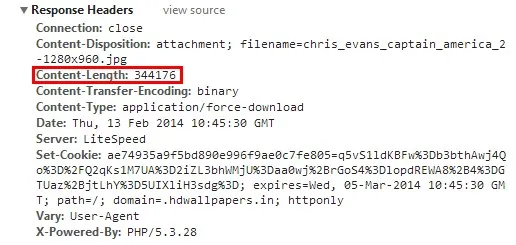这是我的代码:
url = paths[0];
HttpURLConnection connection = (HttpURLConnection) url.openConnection();
int length = connection.getContentLength(); // i get negetive length
InputStream is = (InputStream) url.getContent();
byte[] imageData = new byte[length];
int buffersize = (int) Math.ceil(length / (double) 100);
int downloaded = 0;
int read;
while (downloaded < length) {
if (length < buffersize) {
read = is.read(imageData, downloaded, length);
} else if ((length - downloaded) <= buffersize) {
read = is.read(imageData, downloaded, length - downloaded);
} else {
read = is.read(imageData, downloaded, buffersize);
}
downloaded += read;
publishProgress((downloaded * 100) / length);
}
Bitmap bitmap = BitmapFactory.decodeByteArray(imageData, 0,
length);
if (bitmap != null) {
Log.i(TAG, "Bitmap created");
} else {
Log.i(TAG, "Bitmap not created");
}
is.close();
return bitmap;
我查看了Java文档,长度是负数是因为以下原因:
"内容的字节数,如果无法确定则为负数。如果内容长度已知但超过Long.MAX_VALUE,则返回负数。"
这可能是什么原因?我正在尝试下载一张图片。值得注意的是,这是我尝试下载图像的第四种方法。其他三种方法在这里提到。
编辑:
如所请求,这是我使用的完整方法。
protected Bitmap getImage(String imgurl) {
try {
URL url = new URL(imgurl);
HttpURLConnection connection = (HttpURLConnection) url.openConnection();
int length = connection.getContentLength();
InputStream is = (InputStream) url.getContent();
byte[] imageData = new byte[length];
int buffersize = (int) Math.ceil(length / (double) 100);
int downloaded = 0;
int read;
while (downloaded < length) {
if (length < buffersize) {
read = is.read(imageData, downloaded, length);
} else if ((length - downloaded) <= buffersize) {
read = is.read(imageData, downloaded, length
- downloaded);
} else {
read = is.read(imageData, downloaded, buffersize);
}
downloaded += read;
// publishProgress((downloaded * 100) / length);
}
Bitmap bitmap = BitmapFactory.decodeByteArray(imageData, 0,length);
if (bitmap != null) {
System.out.println("Bitmap created");
} else {
System.out.println("Bitmap not created");
}
is.close();
return bitmap;
} catch (MalformedURLException e) {
System.out.println(e);
} catch (IOException e) {
System.out.println(e);
} catch (Exception e) {
System.out.println(e);
}
return null;
}
